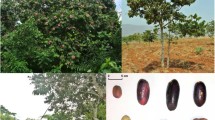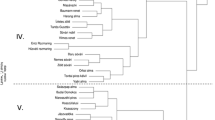Abstract
A Mouthful of Diversity: Knowledge of Cider Apple Cultivars in the United Kingdom and Northwest United States. There is a general assumption in the study of folk taxonomy that those people who have been interacting with a given crop the longest have the most knowledge about the crop’s names. We treated this as an hypothesis which can be tested with knowledge of cider apples. This use of apples extends back many generations in some places, while in other regions people are just learning to make cider. The experimental design is to assess quantitatively the cider apple diversity being used compared to the knowledge of this diversity by cider makers. The test involves two populations of cider makers: those who come from a long-standing tradition of cider making and those who recently learned to make cider. Research was conducted in parts of England, Wales, Northern Ireland, and Washington State, U.S.A. Semistructured interviews and questionnaires were used to elicit cider apple variety names. Traditional knowledge associated with cider production was also collected. Eighty-two cider apple variety names were obtained. In addition, it is estimated that between 111 and 328 varieties were recognized but could not be named. There was a significant difference between the cider apple cultivars that cider makers could name and those that they could discern. On average, cider makers could name eight varieties, but discern 16 varieties of cider apples largely on the basis of appearance, taste, and smell. There was no significant difference in the knowledge of cider apple variety names between long-standing cider makers and those that recently learned to make cider. As with cider apples, we would expect that farmers of other culturally-significant crops would not always know named diversity if there are other cues to let them track varietal difference, such as appearance, taste, or smell.






Similar content being viewed by others
Literature Cited
Alcorn, J. B. 1989. Process as Resource: The Traditional Agricultural Ideology of Bora and Huastec Resource Management and Its Implications for Research. Advances in Economic Botany 7:63–77.
Berkes, F. 1999. Sacred Ecology: Traditional Ecological Knowledge and Resource Management. Taylor and Francis, Philadelphia, Pennsylvania.
Berlin, B. 1992. Ethnobiological Classification. Princeton University Press, Princeton, New Jersey.
Bernard, H. R. 2002. Research Methods in Anthropology: Qualitative and Quantitative Approaches. 3rd ed. Altamira Press, Walnut Creek, California.
Brogdale National Fruit Collection. 2008. www.brogdale.org.
Brosi, B. J., M. J. Balick, R. Wolkow, R. Lee, M. Kostka, W. Raynor, R. Gallen, A. Raynor, P. Raynor, and D. L. Ling. 2007. Cultural Erosion and Biodiversity: Canoe-Making Knowledge in Pohnpei, Micronesia. Conservation Biology 21(3):875–879.
Browning, F. 1998. Apples: The Story of the Fruit of Temptation. North Point Press, New York.
Calhoun, C. L., Jr. 1995. Old Southern Apples. McDonald and Woodward Publishing, Blacksburg, Virginia.
Copas, L. 2001. A Somerset Pomona: The Cider Apples of Somerset. The Dovecote Press, Dorset, England.
Crawford, M. 2001. The Directory of Apple Cultivars. Agroforestry Research Trust, Devon, England.
DEFRA. 2007. Orchard Fruit Survey. Department for Environment, Food and Rural Affairs, York, England.
Estabrook, G. F. 2007. Living Grass Irrigation Ditches in Traditional Portuguese Agriculture: Autecology in the Study of Ethnobotany. Ethnobotany Research and Applications 5:319–330.
French, R. K. 1982. The History and Virtues of Cyder. Robert Hale, Ltd., London.
Gollin, L. X. 2004. Subtle and Profound Sensory Attributes of Medicinal Plants among the Kenyah Leppo’Ke of East Kalimantan, Borneo. Journal of Ethnobiology 24:173–201.
Grenier, L. 1998. Working with Indigenous Knowledge: A Guide for Researchers. International Development Research Centre, Ottawa, Cairo, Dakar, Johannesburg, Montevideo, Nairobi, New Delhi, Singapore.
Harris, S. A., J. P. Robinson, and B. E. Juniper. 2002. Genetic Clues to the Origin of the Apple. TRENDS in Genetics 18 (8):426–430.
Hogg, R. and H. Bull. 1885. The Herefordshire Pomona. Jakeman and Carver, Herefordshire, England.
———. 1886. The Apple & Pear as Vintage Fruits. Jakeman and Carver, Herefordshire, England.
Juniper, B. E. and D. J. Mabberley. 2006. The Story of the Apple. Timber Press, Portland, Oregon.
Knight, T. 1811. Pomona Herefordiensis. Agricultural Society of Herefordshire, London.
Legg, P. 1984. Cidermaking in Somerset. Showerings Limited, Somerset, England.
Mac, F. 2003. Cider in the Three Counties. Logaston Press, Herefordshire, England.
Martin, G. 2003. Editorial from People and Plants. www.peopleandplants.org.
Morgan, J. and A. Richards. 2002. The New Book of Apples: The Definitive Guide to Over 2,000 Varieties. Ebury Press, London.
Nguyen, M. L. T. 2007. Community Dynamics and Functional Stability: A Recipe for Cultural Adaptation and Continuity. Economic Botany 61:337–346.
Price, D. M. and K. Kindscher. 2007. One Hundred Years of Echinacea angustifolia Harvest in the Smoky Hills of Kansas, USA. Economic Botany 61:86–95.
Rivera, D., C. Obón, C. Inocencio, M. Heinrich, A. Verde, J. Fajardo, and J. A. Palazón. 2007. Gathered Food Plants in the Mountains of Castilla–La Mancha (Spain): Ethnobotany and Multivariate Analysis. Economic Botany 61:269–289.
Sandars, N. K. 1960. The Epic of Gilgamesh. Penguin Books, London.
Shanley, P. and N. A. Rosa. 2004. Eroding Knowledge: An Ethnobotanical Inventory in Eastern Amazonia’s Logging Frontier. Economic Botany 58:135–160.
Sheppard, G. H., Jr. 2002. Nature’s Madison Avenue: Sensory Cues as Mnemonic Devices in the Transmission of Medicinal Plant Knowledge among the Matiskenka and Yora of Peru. Pages 326–335 in J. R. Stepp, F. S. Wyndham, and R. K. Zarger, eds., Ethnobiology and Biocultural Diversity. University of Georgia, Athens.
Tidnor Wood Trust. 2008. www.tidnorwood.org.uk.
Vavilov, N. I. 1987. Origin and Geography of Cultivated Plants (translated by Doris Löve). Cambridge University Press, Cambridge, England.
———. 1997. Five Continents (translated by Doris Löve). IPGRI, Rome, VIR, St. Petersburg.
Vogl-Lukasser, B., C. R. Vogl, and H. Reiner. 2007. The Turnip (Brassica rapa L. subsp. rapa) in Eastern Tyrol (Lienz District; Austria). Ethnobotany Research and Applications 5:305–317.
Wheeler, R. 2007. Vintage Fruit CD. Illustrations, color plates, sections, and descriptions of cider apples and perry pears from the classic works of reference. Marcher Apple Network, Shropshire, England.
Williams, R. 1961–1964. Cider Apples and Their Characters—The Long Ashton Annual Reports. Long Ashton Research Station, Somerset, England.
———. 1988. Cider and Juice Apples: Growing and Processing. The University of Bristol Publishing Unit, Bristol, England.
———, C. Todhunter, and R. Shackell. 1987. The Bulmer’s Pomona. Fourth Estate, London.
Williams-Davies, J. 1984. Cider Making in Wales. National Museum of Wales.
Acknowledgments
We would like to thank all of the cider makers who participated in this project. Without your help this research would not have been possible. Thanks to the Herefordshire Cider Museum, Department for Environment, Food and Rural Affairs (DEFRA, UK), Jennet and John Thomas, Niele, and Kalin Raible.
Author information
Authors and Affiliations
Corresponding author
Appendix 1
Appendix 1
Survey questions used in the study of cider apple varieties. Questions were consistently asked of each informant in the order listed below in both the U.S. and U.K. after receiving informed consent and establishing that the informant was a cider producer or cider apple grower. Some questions were omitted for some informants.
-
1.
What apple varieties are being used in your cider production?
-
2.
What varieties are you using?
-
3.
What varieties are you growing?
-
4.
How long has the cider house been in production?
-
5.
What is the style of cider making being employed?
-
6.
Are you experimenting with unusual products?
-
7.
May we use samples of your cider in our taste test experiments in Hawai`i?
-
8.
May we take photographs of the products and facility?
Rights and permissions
About this article
Cite this article
Reedy, D., McClatchey, W.C., Smith, C. et al. A Mouthful of Diversity: Knowledge of Cider Apple Cultivars in the United Kingdom and Northwest United States. Econ Bot 63, 2–15 (2009). https://doi.org/10.1007/s12231-008-9071-2
Received:
Accepted:
Published:
Issue Date:
DOI: https://doi.org/10.1007/s12231-008-9071-2




